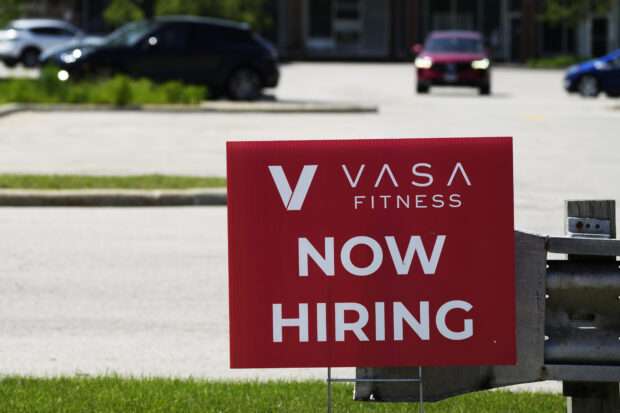US job openings fall to 8.1 million, lowest since 2021

A hiring sign is displayed in Northbrook, Ill., Monday, June 3, 2024. On Tuesday, June 4, 2024, the U.S. Labor Department reports on job openings and labor turnover for April. (AP Photo/Nam Y. Huh)
WASHINGTON — U.S. job openings fell in April to the lowest level since 2021. But they remained at historically high levels despite high interest rates and signs the economy is slowing.
The Labor Department reported Tuesday that employers posted 8.1 million vacancies in April, down from a revised 8.4 million in March. The March figures had originally come in at 8.5 million.
Still, layoffs fell, and the number of Americans quitting their jobs — a sign of confidence in their prospects — rose in April.
Monthly job openings have come down steadily a peak of 12.2 million in March 2022 — as the economy’s recovery from COVID-19 lockdowns left companies desperate for workers — but they remain at a high level. Before 2021, they never topped 8 million — a threshold they have now reached for 38 straight months.
READ: US job openings rise slightly; labor market steadily easing
Article continues after this advertisementThe high level of job openings reflects a surprisingly strong U.S. labor market. When the Federal Reserve began raising interest rates in March 2022 to combat a resurgence in inflation, the higher borrowing costs were expected to tip the economy into recession and push up unemployment.
Article continues after this advertisementInstead, the economy kept growing and employers continued to hire. The United States has averaged 234,000 new jobs a month over the last year.
On Friday, the Labor Department is expected to report that employers added another 180,000 jobs, according to a survey of forecasters by the data firm FactSet.
Unemployment rate seen at 3.9%
The unemployment rate is expected to come in at 3.9 percent, which would be the 28th straight month it’s been below 4%. That would be the longest such streak since a 35-month run from 1951 through 1953 during the Korean War.
Still, high rates are taking a toll. The economy grew at an annual rate of just 1.3 percent from January through March, the slowest since spring 2022.
Much of the first-quarter slowdown was caused by volatile factors such as a surge in imports and a reduction in business inventories.
Consumer spending, which accounts for 70 percent of U.S. economic activity, kept growing but at a slower annual pace — 2 percent, down from 3.3 percent in the last three months of 2023.
READ: US economic growth in Q1 revised down from 1.6% to 1.3%
The economy had been expected to get a lift from lower rates. The Fed signaled that it planned to cut its benchmark rate three times this year. But the start of the cuts keeps getting pushed back because inflation remains stubbornly above the central bank’s 2 percent target.
Now Wall Street investors don’t expect the first cut until the Fed’s September meeting, according to the CME FedWatch tool.
Fed policymakers likely welcome lower job openings — a relatively painless way to cool a hot job market and reduce pressure on companies to raise wages, which can feed inflation.
“Overall, job openings are still elevated, signaling strong demand for workers,” said Rubeela Farooqi, chief U.S. economist at High Frequency Economics. ”But they continue to move in the right direction, towards pre-pandemic readings, pointing to an ongoing normalization between supply and demand for labor.”